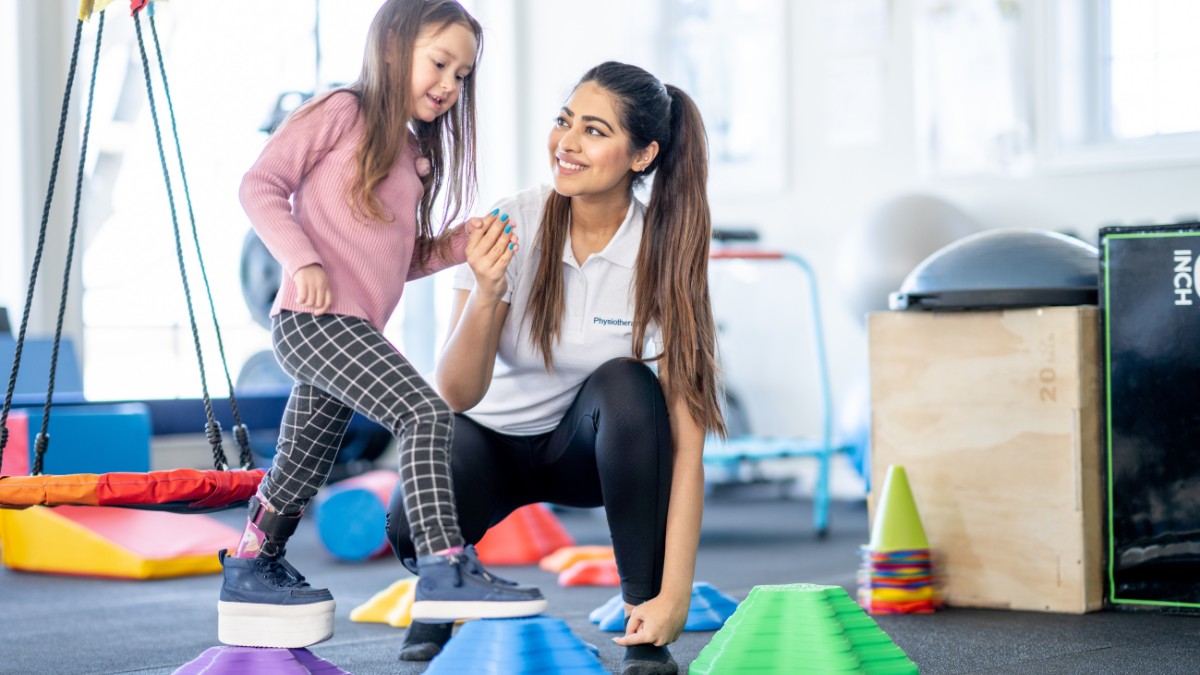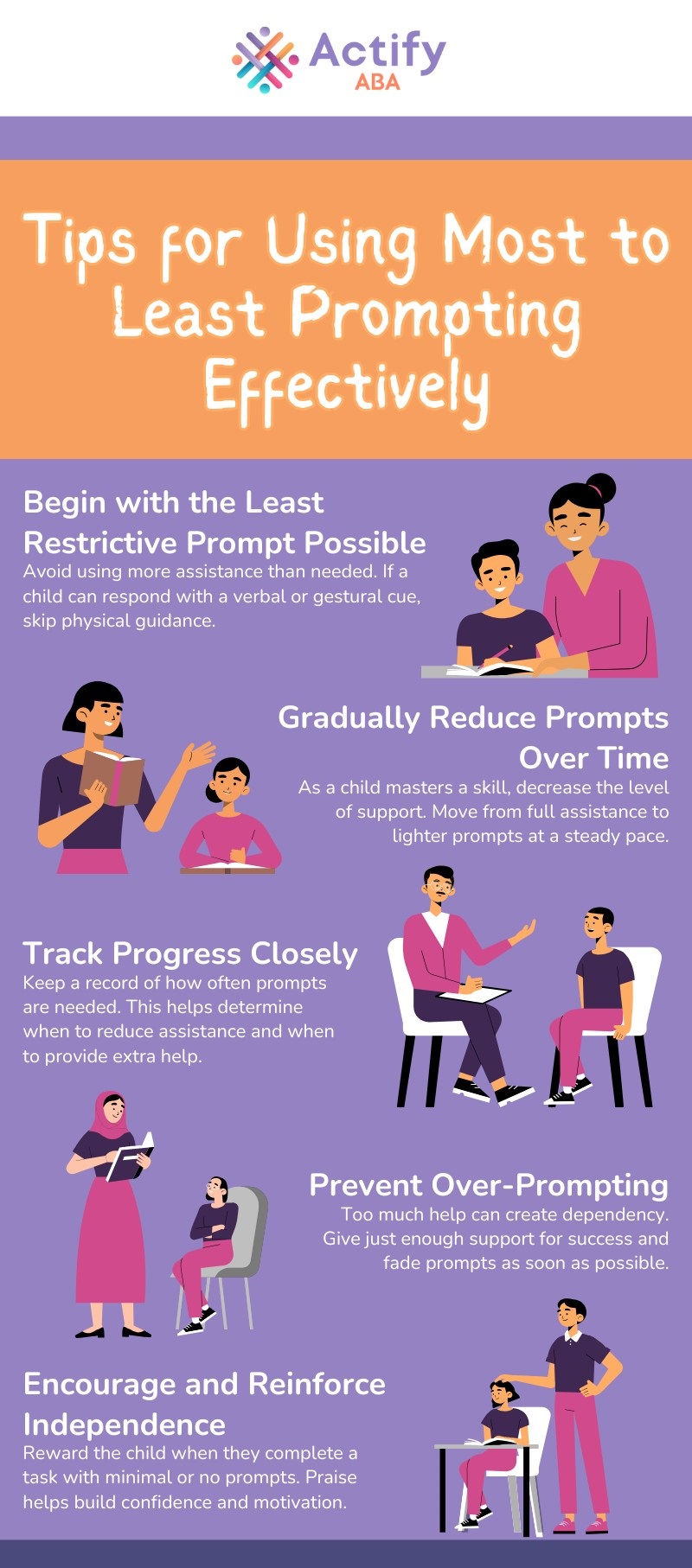
Key Points:
- Most to least prompting in ABA helps children learn new skills by gradually reducing assistance.
- This method ensures independence by starting with full support and slowly fading prompts.
- Parents and therapists use it for tasks like dressing, writing, and social skills.
Every parent wants their child to be independent, but getting there can feel overwhelming. Whether it’s brushing teeth, getting dressed, or making a request, some skills require extra guidance. That’s where most to least prompting comes in—a structured ABA method that helps children learn step by step. But how does it work, and how can you use it effectively?
What is the Most to Least Prompting in ABA?
Most to least prompting in ABA is a technique where a child receives maximum assistance at the start, and the level of help gradually decreases as they learn. This ensures they develop the correct response before becoming independent.
For example, if a child is learning to tie their shoes:
- The therapist may start by physically guiding their hands (full physical prompt).
- As the child improves, the therapist reduces to a light touch (partial physical prompt).
- Later, they provide only verbal reminders.
- Eventually, the child ties their shoes independently.

Why Is Most to Least Prompting Effective in ABA?
Most to least prompting is a structured method in ABA therapy that provides the right level of assistance while gradually promoting independence. It ensures that children learn correctly while preventing frustration and reliance on prompts. Here’s why it works:
Prevents Errors and Frustration
When learning a new skill, mistakes can be discouraging and slow progress. Starting with full support helps the child complete the task correctly multiple times before attempting it independently. Repetitive success builds confidence and familiarity, making the transition to independence smoother.
Encourages Self-Sufficiency
The structured fading of prompts ensures that children develop confidence in their abilities without abrupt withdrawal of support. This gradual reduction prevents the child from becoming overly dependent on an adult’s help. Over time, they learn that they can complete tasks without additional guidance.
Reduces Prompt Dependency
Some children struggle to transition away from adult-provided prompts. By systematically decreasing the level of assistance, this approach encourages the child to complete tasks without expecting ongoing help. This is crucial for building long-term independence and problem-solving skills.
Works for a Variety of Skills
Most to least prompting applies to a wide range of abilities, including daily living tasks, communication, social interactions, and academics. It is especially useful for multi-step activities such as dressing, handwashing, writing, and preparing meals. Because it can be customized to different skill levels, it supports progress across multiple developmental areas.
Most to Least Prompting ABA Example
Understanding how most to least prompting works in real situations can help parents and caregivers apply it effectively. Below are three practical examples demonstrating how this technique supports skill development across daily activities, academics, and social interactions.
1. Teaching Handwashing
At first, the therapist provides full physical assistance, guiding the child’s hands through each step—turning on the water, applying soap, scrubbing, rinsing, and drying. As the child gains familiarity, the therapist reduces physical support, using only light touches. Eventually, the therapist transitions to gestures, such as pointing at the soap, and then to verbal instructions. Over time, prompts are removed entirely, allowing the child to wash their hands without assistance.
2. Learning to Write a Name
Initially, the therapist uses hand-over-hand support, physically guiding the child’s fingers to trace each letter. As the child becomes more comfortable, they move to partial physical prompts, such as tapping the child’s hand to encourage movement. Later, the therapist models the action by writing the name first and asking the child to copy it. Eventually, only verbal reminders are given until the child can independently write their name.
3. Developing Social Skills (Saying Hello)
When teaching a child to greet others, the therapist may start with a full verbal prompt, saying, “Say ‘Hi, my name is Alex.’” As the child becomes more comfortable, the prompt fades to just “Say ‘Hi…’” and then to a simple nod or expectant pause. Over time, the child learns to greet others naturally, without needing assistance, building confidence in social situations.
Using most to least prompting correctly helps children build independence without becoming reliant on help. Here are some key strategies to follow:

How Parents Can Use Most to Least Prompting at Home
Parents can easily apply most to least prompting in daily routines to support their child’s learning. Whether teaching life skills, social interactions, or chores, this method helps build independence.
During self-care routines like brushing teeth or getting dressed, start with full assistance and gradually reduce help. For example, guide their hand to squeeze toothpaste at first, then fade to a verbal reminder.
Playtime offers natural opportunities for prompting. If a child struggles with turn-taking, begin with a full verbal prompt like “Say ‘my turn,’” then transition to just a gesture.
Household chores also reinforce independence. If teaching cleanup, start by physically helping them put away toys, then shift to pointing at the items before they complete the task independently.
Partner with Actify for Expert Support
Understanding most to least prompting ABA examples can help parents and caregivers teach skills effectively. By gradually reducing assistance, children gain independence and confidence in their abilities.
If you’re looking for professional ABA therapy, Actify is here to help. Our expert team creates personalized learning plans tailored to your child’s unique needs. Whether working on communication, daily living skills, or academics, we provide the support needed for long-term success.
We proudly serve families in Maryland and surrounding areas. Contact us today to learn more about how our ABA services can help your child grow and thrive!
